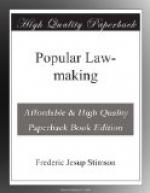VII
AMERICAN LEGISLATION ON PROPERTY RIGHTS
When we come to the vast field of legislation in the United States, comprising the law-making of forty-six States, two Territories, the National Congress, and the Federal District, it is difficult to decide how to divide the subject so as to make it manageable. The division made by State codes and revisions, and the United States Revised Statutes, hardly suits our purpose, for it is made rather for lawyers than sociologists or students in comparative legislation. The division made by the valuable “Year Book of Legislation,” published by the New York State Library, comprises some twenty subjects: Constitutional Law; Organic Law; Citizenship and Civil Rights; Elections; Criminal Law; Civil Law; Property and Contracts; Torts; Family; Corporations; Combinations and Monopolies; Procedure; Finance; Public Order; Health and Safety; Land and Waters; Transportation; Commerce and Industry; Banking; Insurance; Navigation and Waterways; Agriculture; Game and Fish; Mines and Mining; Labor; Charities; Education; Military Matters; and Local Government. This division, however convenient in practice, crosscuts the various fields of legislation as divided in any logical manner. The same criticism may be applied to a somewhat simpler division I have used in tabulating State legislation for the last twenty years into thirteen columns, the titles of these being, roughly speaking, Property and Taxation; Regulation of Trades and Commercial Law; Personal Liberty and Civil Rights; Labor; Criminal Law, Health and Morality; Government; Elections and Voting; Courts and Procedure; Militia and Military Law; Women, Children, Marriage and Divorce; Charities, Education, Religion and Jails; Agriculture, Mining and Forestry; Corporations, Trusts and Interstate Commerce. Is it not possible to begin with a broader and more simple division?




